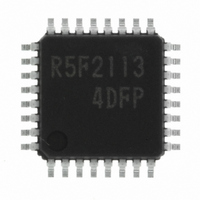R5F21134DFP#U0 Renesas Electronics America, R5F21134DFP#U0 Datasheet - Page 19

R5F21134DFP#U0
Manufacturer Part Number
R5F21134DFP#U0
Description
IC R8C MCU FLASH 32LQFP
Manufacturer
Renesas Electronics America
Series
M16C™ M16C/R8C/Tiny/13r
Datasheets
1.R5F211A2SPU0.pdf
(300 pages)
2.R5F21132FPU0.pdf
(33 pages)
3.R5F21132FPU0.pdf
(226 pages)
4.R5F21134DFPU0.pdf
(224 pages)
Specifications of R5F21134DFP#U0
Core Size
16-Bit
Program Memory Size
16KB (16K x 8)
Oscillator Type
Internal
Core Processor
R8C
Speed
20MHz
Connectivity
SIO, UART/USART
Peripherals
LED, POR, Voltage Detect, WDT
Number Of I /o
22
Program Memory Type
FLASH
Ram Size
1K x 8
Voltage - Supply (vcc/vdd)
2.7 V ~ 5.5 V
Data Converters
A/D 12x10b
Operating Temperature
-40°C ~ 85°C
Package / Case
32-LQFP
No. Of I/o's
22
Eeprom Memory Size
4KB
Ram Memory Size
1024Byte
Cpu Speed
20MHz
No. Of Timers
16
Digital Ic Case
RoHS Compliant
Controller Family/series
R8C/13
Rohs Compliant
Yes
Lead Free Status / RoHS Status
Lead free / RoHS Compliant
For Use With
R0K521134S000BE - KIT EVAL STARTER FOR R8C/13R0E521134EPB00 - KIT EMULATOR PROBE FOR PC7501R0E521134CPE00 - EMULATOR COMPACT R8C/13
Eeprom Size
-
Lead Free Status / RoHS Status
Lead free / RoHS Compliant
Available stocks
Company
Part Number
Manufacturer
Quantity
Price
Part Number:
R5F21134DFP#U0R5F21134DFP
Manufacturer:
Renesas Electronics America
Quantity:
10 000
- R5F211A2SPU0 PDF datasheet
- R5F21132FPU0 PDF datasheet #2
- R5F21132FPU0 PDF datasheet #3
- R5F21134DFPU0 PDF datasheet #4
- Current page: 19 of 224
- Download datasheet (3Mb)
R8C/13 Group
Rev.1.20
REJ09B0111-0120
2.2 Address Registers (A0 and A1)
2.3 Frame Base Register (FB)
2.4 Interrupt Table Register (INTB)
2.5 Program Counter (PC)
2.6 User Stack Pointer (USP) and Interrupt Stack Pointer (ISP)
2.7 Static Base Register (SB)
2.8 Flag Register (FLG)
A0 is a 16-bit register for address register indirect addressing and address register relative addressing.
They also are used for transfer, arithmetic and logic operations. The same applies to A1 as A0. A0 can be
combined with A0 to be used as a 32-bit address register (A1A0).
FB is a 16-bit register for FB relative addressing.
INTB is a 20-bit register indicates the start address of an interrupt vector table.
PC, 20 bits wide, indicates the address of an instruction to be executed.
The stack pointer (SP), USP and ISP, are 16 bits wide each.
The U flag of FLG is used to switch between USP and ISP.
SB is a 16-bit register for SB relative addressing.
FLG is a 11-bit register indicating the CPU state.
2.8.1 Carry Flag (C)
2.8.2 Debug Flag (D)
2.8.3 Zero Flag (Z)
2.8.4 Sign Flag (S)
2.8.5 Register Bank Select Flag (B)
2.8.6 Overflow Flag (O)
2.8.7 Interrupt Enable Flag (I)
2.8.8 Stack Pointer Select Flag (U)
2.8.9 Processor Interrupt Priority Level (IPL)
2.8.10 Reserved Bit
The C flag retains a carry, borrow, or shift-out bit that has occurred in the arithmetic logic unit.
The D flag is for debug only. Set to “0”.
The Z flag is set to “1” when an arithmetic operation resulted in 0; otherwise, “0”.
The S flag is set to “1” when an arithmetic operation resulted in a negative value; otherwise, “0”.
The register bank 0 is selected when the B flag is “0”. The register bank 1 is selected when this flag is
set to “1”.
The O flag is set to “1” when the operation resulted in an overflow; otherwise, “0”.
The I flag enables a maskable interrupt.
An interrupt is disabled when the I flag is set to “0”, and are enabled when the I flag is set to “1”. The
I flag is set to “0” when an interrupt request is acknowledged.
ISP is selected when the U flag is set to “0”, USP is selected when the U flag is set to “1”.
The U flag is set to “0” when a hardware interrupt request is acknowledged or the INT instruction of
software interrupt numbers 0 to 31 is executed.
IPL, 3 bits wide, assigns processor interrupt priority levels from level 0 to level 7.
If a requested interrupt has greater priority than IPL, the interrupt is enabled.
When write to this bit, set to “0”. When read, its content is indeterminate.
Jan 27, 2006
page 8 of 205
2. Central Processing Unit (CPU)
Related parts for R5F21134DFP#U0
Image
Part Number
Description
Manufacturer
Datasheet
Request
R

Part Number:
Description:
KIT STARTER FOR M16C/29
Manufacturer:
Renesas Electronics America
Datasheet:

Part Number:
Description:
KIT STARTER FOR R8C/2D
Manufacturer:
Renesas Electronics America
Datasheet:

Part Number:
Description:
R0K33062P STARTER KIT
Manufacturer:
Renesas Electronics America
Datasheet:

Part Number:
Description:
KIT STARTER FOR R8C/23 E8A
Manufacturer:
Renesas Electronics America
Datasheet:

Part Number:
Description:
KIT STARTER FOR R8C/25
Manufacturer:
Renesas Electronics America
Datasheet:

Part Number:
Description:
KIT STARTER H8S2456 SHARPE DSPLY
Manufacturer:
Renesas Electronics America
Datasheet:

Part Number:
Description:
KIT STARTER FOR R8C38C
Manufacturer:
Renesas Electronics America
Datasheet:

Part Number:
Description:
KIT STARTER FOR R8C35C
Manufacturer:
Renesas Electronics America
Datasheet:

Part Number:
Description:
KIT STARTER FOR R8CL3AC+LCD APPS
Manufacturer:
Renesas Electronics America
Datasheet:

Part Number:
Description:
KIT STARTER FOR RX610
Manufacturer:
Renesas Electronics America
Datasheet:

Part Number:
Description:
KIT STARTER FOR R32C/118
Manufacturer:
Renesas Electronics America
Datasheet:

Part Number:
Description:
KIT DEV RSK-R8C/26-29
Manufacturer:
Renesas Electronics America
Datasheet:

Part Number:
Description:
KIT STARTER FOR SH7124
Manufacturer:
Renesas Electronics America
Datasheet:

Part Number:
Description:
KIT STARTER FOR H8SX/1622
Manufacturer:
Renesas Electronics America
Datasheet:

Part Number:
Description:
KIT DEV FOR SH7203
Manufacturer:
Renesas Electronics America
Datasheet:











